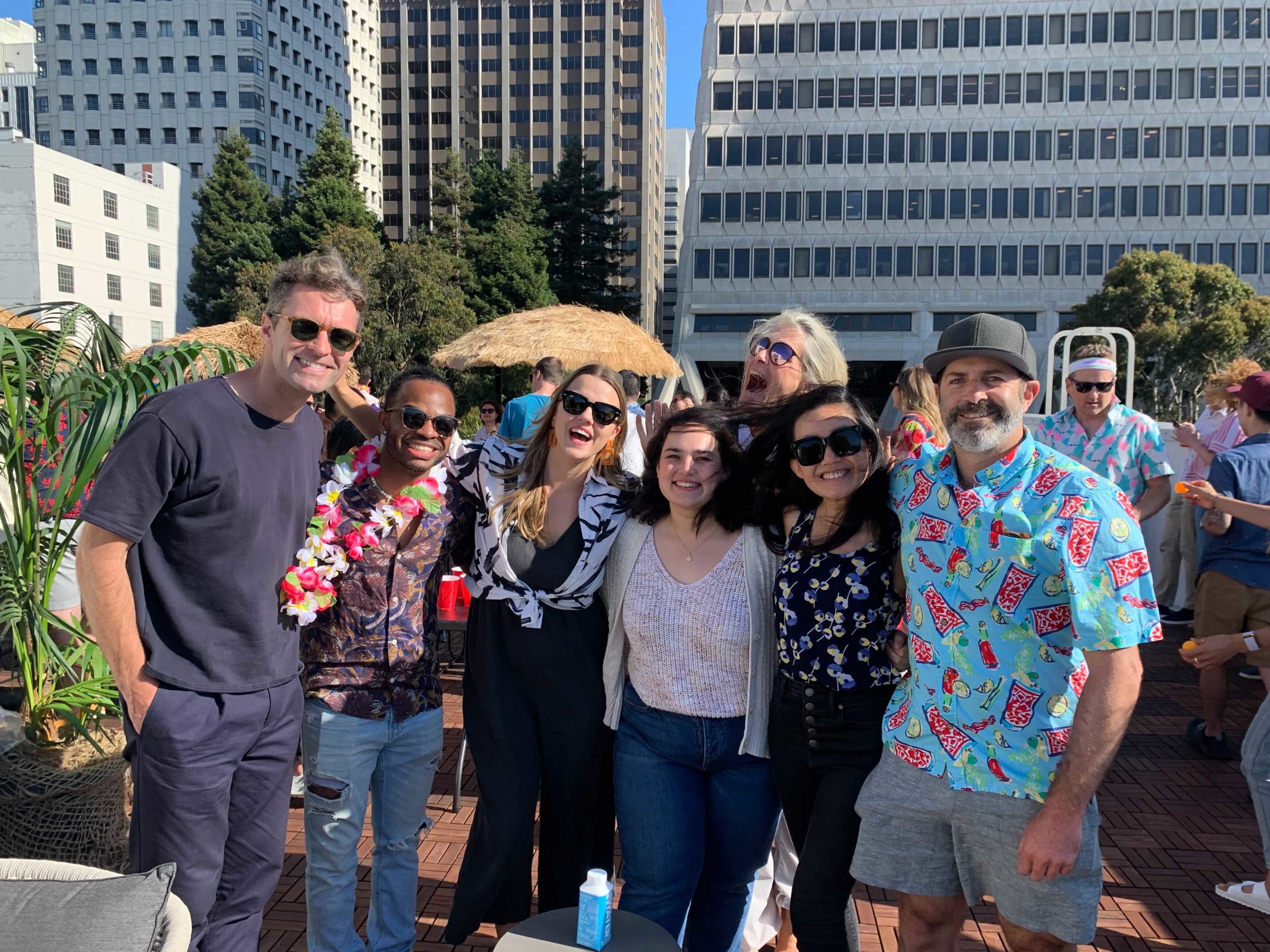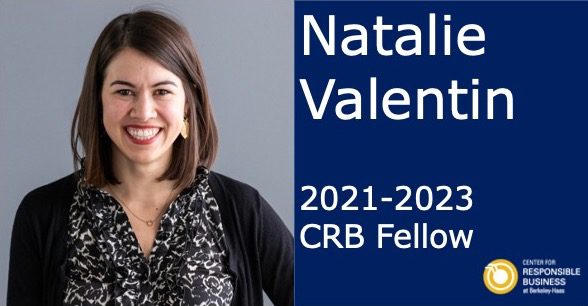Building Sustainable Chemistry with Levi Strauss & Co.

Levis Strauss is a longtime partner of both the Haas School of Business and the Center for Responsible Business. As a leader in the sustainable apparel industry, Levi’s has challenged and inspired many of the students who pass through Haas.
Their role as industry leaders goes back decades. In 2000, they were one of the first companies to issue Restricted Substance List (opens in a new tab). In 2013, they launched their Screened Chemistry (opens in a new tab) program. That initiative looked at the potential human and environmental impact of chemicals before they enter the supply chain and try to find alternatives for those that were unsafe. Now, Levi’s is partnering with other major clothing brands like Nike, H&M, and C&A to standardize their chemical management to a process that resembles the Screened Chemistry program.
In this piece, we’ll look back at the stories covering the major milestones of the CRB’s 10 years of partnering for impact with Levi’s:
2010 | Levi’s Sustainability Undergraduate Case Competition
In 2010, the Center for Responsible Business partnered with the California College of the Arts in challenging undergraduate students to create innovative solutions on how Levi Strauss can “close the loop profitably” with denim recycling, reuse, and resale. Rosalind Chu, Berkeley Haas B.S.B.A. ‘11 and former Corporate Communications Specialist at Levi Strauss & Co., summarized the case competition’s impact. Read the full original post here (opens in a new tab).
What happens when you bring left-brainers together with right-brainers? This semester, the Center for Responsible Business (CRB) partnered with California College of the Arts (CCA) to find out. Sustainable fashion design students from CCA were paired with students from UC Berkeley to work on the Levi’s Sustainability Undergraduate Case Competition. Participants were asked to create innovative solutions on how Levi Strauss can “close the loop profitably” with denim recycling, reuse, and resale.
Asking the teams to provide a physical prototype of their idea allowed students to commit and engage fully in developing their solutions. The prototypes included jean jackets, raw materials for textile production, a new type of stitching, a jacket made from recycled denim yarn, replacement pant pieces, and even handkerchiefs.
“The teams from the different schools were challenged to come together and develop a solution that was not only creative, but business viable, and of course environmentally sustainable,” said Jo Mackness, then Executive Director at the CRB. “We were trying to create an experiential learning opportunity that mimics the cross functional context within which students will eventually operate in the ‘real world’ —interestingly, it was the students who collaborated the best—really embraced their teammates’ ideas, who came out with the best all around solutions.”
UC Berkeley and CCA students came together successfully to not only tackle the case from both a design and business perspective, but more importantly, apply the skills and knowledge they learned in the classroom (and studio, for CCA students) to a real-world business challenge.
2013 | Partner Spotlight on Michael Kobori, VP Sustainability
Michael Kobori, Center for Responsible Business (CRB) Advisory Board Member and VP of Social & Environmental Sustainability at Levi Strauss & Co., shared his thoughts about partnering with the Center for Responsible Business at Berkeley Haas back in 2013.
2016 | CRB Fellow Drives Levi’s Screened Chemistry Program
Kyle Rudzinski, a 2014 Haas alum and a former Center for Responsible Business fellow, landed a role at Levi Strauss and Co. on their Sustainability Innovation Leadership Team after graduation. In 2016, Rudzinski sat down with the Center for Responsible Business to share more about his role at Levi’s as well as some personal anecdotes of the CRB / Levi Strauss partnership in action. Read the full original post here (opens in a new tab)
CRB: Could you tell us more about your position in depth?
KR: Most of my job is sharing the sustainability story at Levi’s. We have done a ton of great things in terms of supporting worker rights, going beyond compliance measures, and helping people with things like health education, access to water purifiers and solar lamps, and financial literacy education. Our impact goes beyond factories and into the communities, as we are really trying to make sure we empower our workers across the globe. We want to figure out the best way to share that kind of story so that our work reaches the consumer. That means my job involves working cross-functionally across a matrixed organization and influencing without authority, getting different people on board with different parts of our sustainability strategy.
CRB: What is your favorite product or initiative that you have been working on?
KR: We did a life cycle assessment on our iconic 501 jeans in 2007. We determined one of our biggest environmental impacts is around water. We updated that assessment this year with the latest science and it reaffirmed that water is a huge consideration for us. We realized that the average pair of jeans consumes nearly 3,800 liters of water throughout its life. About 68% of that water is used to grow the cotton. Only 9% is used in manufacturing – which is the area we can most directly affect. The other 23% of water is used in consumer care.
So for us, we try to figure out how to shift the industry and how to create change that goes far beyond our company alone. Once we conducted these life cycle assessments, we learned where to act, where to focus our attention. We continue to innovate and use Water<Less techniques that can save up to 96% of the water in the denim finishing process. We recently released our first product with Water<Less fabric, which saves about 65% of the water normally used in the dye process. It’s part of our limited run Wellthread product which blends multiple parts of sustainability – from benefitting workers to considering recyclability in the design – but focuses on saving water.
CRB: How does your team integrate responsible practices into Levi’s as a whole?
KR: There are different evolutions in companies in terms of their sustainability journey. Our company has a long history of achieving strong results – whether it is with workers, with water, with the environment, with chemistry. Whatever it might be, we have done a very good job with achieving strong results. We are still in the stage where we have a sustainability department. We are making the transition to fully embedding sustainability across the company. We are working with more partners in different parts of the business, discovering who our previously overlooked sustainability champions are, and making sure what our team is doing aligns with what the business is doing.
2017 | Driving the Adoption for Green Chemistry
The Center for Responsible Business is able to bring the cutting-edge of sustainable innovation to business school students globally through the development of cases with our partners. In 2017, Levi Strauss and the Center for Responsible Business published Driving Adoption of Green Chemistry (opens in a new tab), a look at the challenges and opportunities faced by Levi Strauss as they work to establish a cross-industry sustainability initiative to eliminate hazardous chemicals in the apparel supply chain.
The publication of the case was followed by an industry roundtable convened by the Center for Responsible Business and Levi Strauss at Berkeley Haas. Below is an overview written by Anne Kramer (opens in a new tab), former CRB Student Advisory Board & MBA ’18, who now works on sustainable product innovation at Nike. Read the full original post here. (opens in a new tab) (opens in a new tab)
Collaborating with the Center for Responsible Business, Levi’s sponsored a forum at Berkeley Haas in March of 2017. Centered around the Center for Responsible Business’ case study titled “Driving the Adoption for Green Chemistry (opens in a new tab),” the event allowed leaders across apparel, chemical, data, investment, and other industries to learn about Levi’s screened chemistry approach and find a path to greater political will together. The event convened more than 80 representatives from diverse organizations, including Apple, Patagonia, and Seventh Generation.
Three key themes for improvement stood out:
- The need for harmonization of standards across the industry. The proliferation of brand-specific standards in sustainable chemistry has meant that manufacturing facilities and chemical suppliers need to reconcile several nearly identical requirements. These redundant standards take up time and cause costly inefficiencies, creating confusion rather than driving action. Collaboration at an industry level is desperately needed. Brands recognized that the burden for collaboration lies heavily with them and understood that leading by example might not be enough. Hopefully, a standard will eventually emerge in the apparel industry that will drive both action and value.
- The need for more green innovation at all levels of the supply chain. Big brands like Levi’s were motivated to implement a screened chemistry program because it was the right thing to do. But smaller companies and chemical suppliers indicated the need for greater incentives to innovate. All stakeholders recognized that they each have talents and skills that, if leveraged as a collective, can create those incentives for innovation.
- Supporting this type of program will require significantly more transparency and education than exists today. Within the industry, there were calls to democratize access to green chemistry information, R&D data, and tools. Externally, all recognized the need to educate the consumer, since they – more than any other actor – have the power to influence what’s contained in their products.
2019 | Collaborative Innovation for the Future of Screened Chemistry
The publication of “Driving the Adoption for Green Chemistry (opens in a new tab)” and the associated industry roundtable laid the groundwork for the launch of a single standard for chemical management spearheaded by Levi Strauss & Co. Below is an announcement of the launch of the new Screened Chemistry industry standard published on the company’s blog Unzipped (opens in a new tab). Levi’s drive to innovate openly for sustainability took years to achieve and the Center for Responsible Business is proud to be a thought partner on that journey.
Levi Strauss & Co. has long been committed to identifying and removing potentially harmful chemical formulations from our supply chain.
In 2000, we were one of the first companies to issue a Restricted Substances List. In 2012, we joined the Joint Roadmap Toward Zero Discharge of Hazardous Chemicals, which we pledged to reach zero discharge of hazardous chemicals by 2020 (the Roadmap is overseen by the ZDHC Foundation). Then, in 2013, we launched our Screened Chemistry program, which sought to understand the potential human and environmental impact of chemicals before they enter the supply chain, and to find alternatives for anything deemed unsafe.
And now we are converging with other apparel brands – including Nike, H&M and C&A – to adopt a single standard for chemical management closely resembling the Screened Chemistry program we pioneered. We’re coming together with the ZDHC Foundation, who will oversee the effort, to create a holistic approach to tackling issues of hazardous chemicals and driving innovation in the apparel industry.
From the outset of our Screened Chemistry program, we knew that a collaborative effort would generate a greater impact than any one company could. That’s why we shared our approach publicly in 2016, and a year later convened the business community to further encourage adoption and understanding. It served as an impetus for others like Gap Inc., which is currently piloting its own version of the program.
And last year, LS&Co. was named to Fortune magazine’s “Change the World” list for the second year in a row — this time for our pioneering efforts around our Screened Chemistry program.
“This is something we’ve been working towards for many years,” said Bart Sights, vice president of technical innovation. “An industry-wide effort is needed to drive change and to reduce the overall environmental impact not only of our companies, but our entire industry.”



